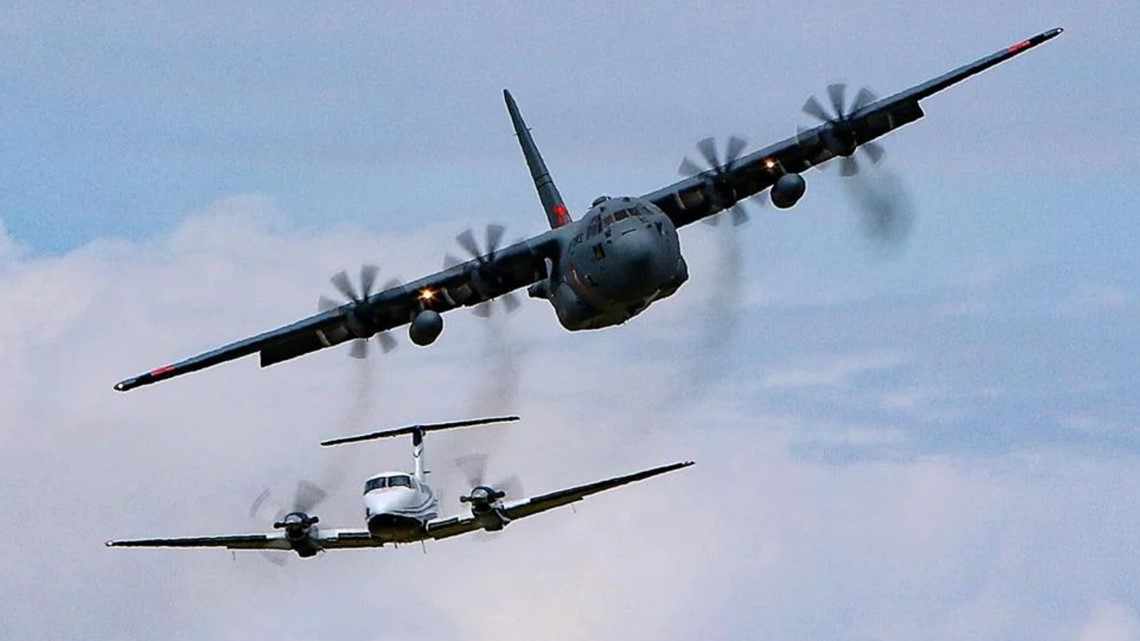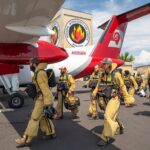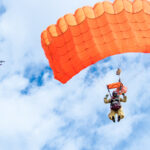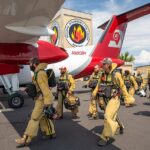
The Ninety-Nines International Organization of Women Pilots was established in 1929 by 99 female pilots, including Amelia Earhart, to promote aviation education.
NAMPA, Idaho — This article originally appeared in the Idaho Press.
Idaho 99 Chapter Chair Kathryn Hughes climbed into her 1963 Bonanza Debonair like it was a car. After buckling in and locking the passenger-side door, Hughes pulled out a paper smaller than a 3×5 and went down her checklist. Though she is a seasoned pilot, Hughes lives by the philosophy “better safe than sorry,” particularly when flying.

Kathryn Hughes, chapter chair of the Idaho 99s, talks with fellow members during a breakfast meeting at the Nampa Airport, Saturday, Feb. 11, 2023.
Saturday morning found several members of the Idaho 99 gathered at the Nampa Airport for breakfast. Half-eaten slices of avocado toast, cinnamon rolls and breakfast burritos were all that was left by 11 a.m. Female pilots, some new to aviation and some legendary, laughed and talked about their passions together — every one of them shared the same adventurous glint in their eyes, like they were about to do something wildly unexpected at any moment.
The Ninety-Nines International Organization of Women Pilots was originally established in 1929 by 99 female pilots, including Amelia Earhart, to promote aviation education. The now-international organization has scholarships to support people in their passion for aviation: Idaho has two chapters, each with major girl power.
Gene Nora Jessen, who sat by her daughter in the corner of the room, is Hughes’ hero and one of the big reasons she got involved with aviation, Hughes said.
Jessen is a “certified legend” in the Idaho 99, Hughes said. Featured on the Netflix documentary Mercury 13 that tells the story of a group of female pilots who were tested for spaceflight in the 1960s and then asked to step aside because only men were selected for the flight, Jessen moved to Boise in 1966, but had been a 99 years earlier in Kansas. In 1987, she was the International President of the 99s.
For Jessen, aviation quickly became about the people.
“The best part of the job was meeting so many interesting and wonderful people, and traveling, too,” Jessen said.
She learned to fly at 17, and later taught many to fly, including her daughter, Briana LeClaire.
LeClaire grew up around airplanes. The passion was passed down to her, she said.
“I didn’t know any different,” LeClaire said. “Both of my folks flew … it was normal.”
Her parents owned and ran the Boise Air Service, which is where her passion for aviation was sparked, LeClaire said.

Female aviators Lisa Allen, , at left, Gene Nora Jessen, center, and her daughter Briana LeClaire, at rigth, share a conversation during a meeting of the Idaho 99s at the Nampa Airport, Saturday, Feb.11, 2023.
Their work as a family in aviation is something LeClaire and Jessen hope to see the Idaho 99 do, encouraging women of all ages to learn to fly — watching that happen, LeClaire said, is inspiring. She wants every girl to have the same experience she did, watching her mom fly through the skies, unrestricted and free.
“It’s the normalization of women in aviation. What a concept,” LeClaire said. “It’s important for aviators to give back to the community.”
Those service-oriented aviators are the reason many of the Idaho 99 found their passion for piloting — including Jessen, who found aviation through the Civil Air Patrol.
Aviation isn’t limited to work in the skies.
Lisa Allen is a Bureau of Land Management firefighting lead plane pilot, coordinating the airspace and keeping air tankers and helicopters fighting fires safe. She’s previously worked as a smoke jumper, flying to remote wildland fires and dropping down to fight the fires by parachute.
Allen learned to fly at 19 and quickly discovered that leaving the ground was “pure freedom.” She couldn’t get enough.
“I like the adventure of it,” Allen said. “I can be a little antsy on the ground. Get in the air and everything’s right.”
Like so many of its members, Allen quickly became involved with the Idaho 99.
“(The 99) is an inspiration for young girls to see somebody that looks like them and think, ‘I can do that,’” Allen said. “I get to fly over some of the most beautiul country in the world.”
And that’s something everyone should have the opportunity to do, Allen said.
Stacey Budell, the Northwest Section Governor of the 99s, found aviation in a bumpy flight in a small airplane. The flight, piloted by a crop duster, was so horrific that one of the passengers wet himself, Budell recalls. She became a licensed pilot one year after that, in 1992, and became involved with the 99s quickly after.
“Amelia started it as a support group for women. It’s still very much a man’s world,” Budell said. “I’ve experienced that first hand … not all men are as supportive as the men we have supporting us.”
In her experience, flying in the backcountry and as CFII instructor, women are treated differently than men. The men she’s worked with often “forgot” that she was a pilot and told her to take a truck somewhere instead of her plane.
“You just get treated differently. … They’re (men are) either really hard on you or they’re condescending — it’s too bad it’s that way,” Budell said.
Those experiences made it impossible for Budell to not get involved with the 99s.
“It’s kept me current and kept me flying all these years,” Budell said. “It’s so diverse, that’s why I love the group. … We all have camaraderie and support each other.”
In addition to her work with the organization, Budell owns her own company, working as a real estate broker. But in the early mornings, before the sun has peaked over the foothills, Budell takes to the skies in her Cessna 182.
“Flying during that time, it changes your mood,” she said. “If I’m lucky I fly every day, in the early mornings. … I love getting off the ground.”
The best thing she ever did for herself was learning to fly, Budell said. It brought her incredible freedom and lifelong friends, she said.
“The ladies that I have met here have become some of my best and closest friends,” Budell said. “It doesn’t matter where you go in the world, we can call on one of our sisters for help.”
Growing up, Hughes said, she wanted to play hockey and go to medical school. But when college funds fell short, she decided to attend the Air Force Academy. She started pilot training at 22 and later became an Air Force instructor. In 1988, Hughes flew T-37 and T-38 planes at Laughlin Air Force Base as an instructor, or an FAIP.
Being a minority in the aviation world as a woman, Hughes bunked with the only other woman there. Later, she attended medical school in Nebraska, attending a pilot physician program at the University of Nebraska Medical Center. Her niche, Hughes said, became life support equipment. After flying around the United Kingdom, Hughes moved to Council, Idaho, purchasing her 1963 Bonanza Debonair.
After Saturday’s breakfast, Hughes took to the skies, heading home to Council. Houses, cars and mountains shrink beneath her as she heads toward the clouds, continuously breaking the glass ceiling for Idaho’s future female pilots.
This article originally appeared in the Idaho Press, read more on IdahoPress.com.






